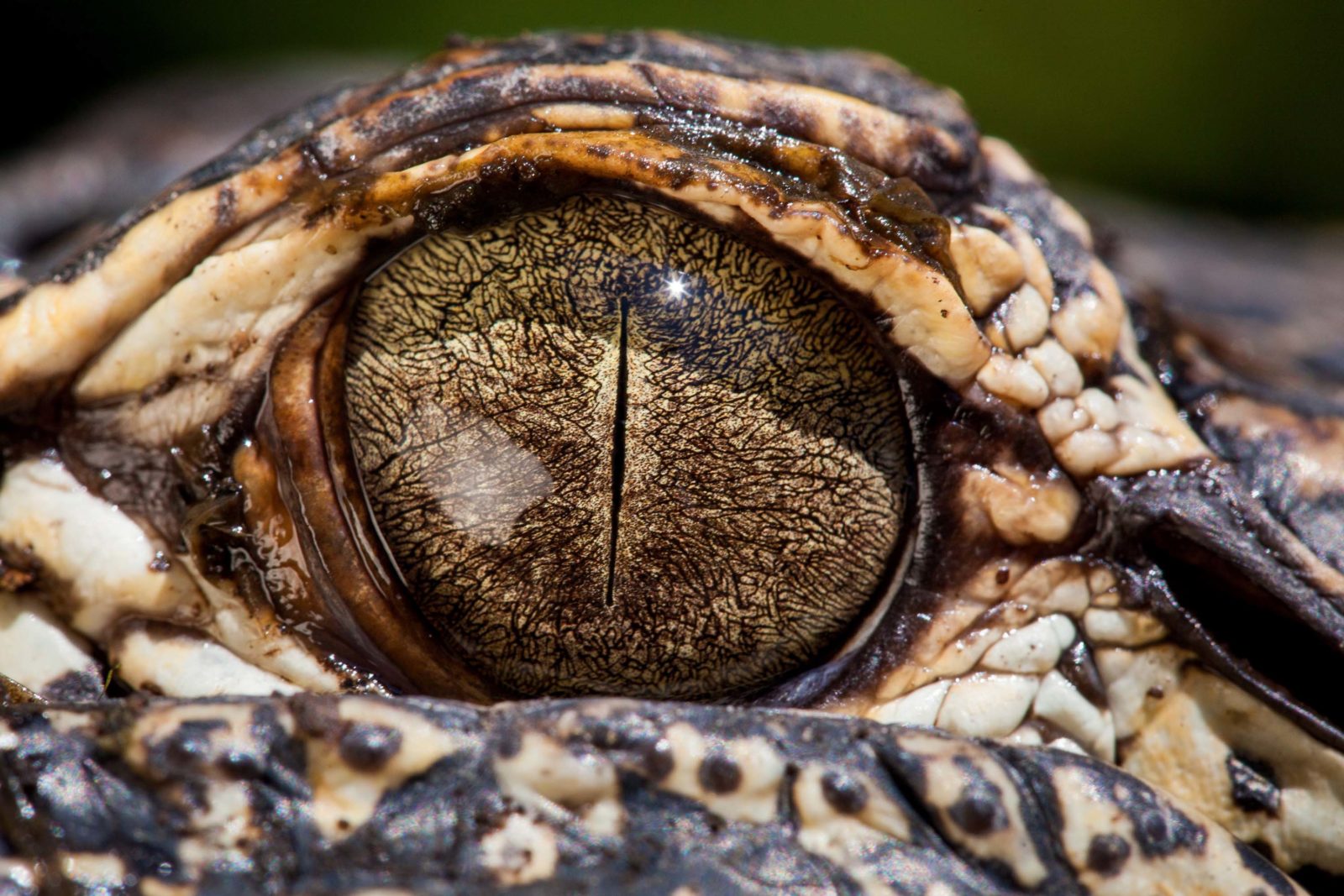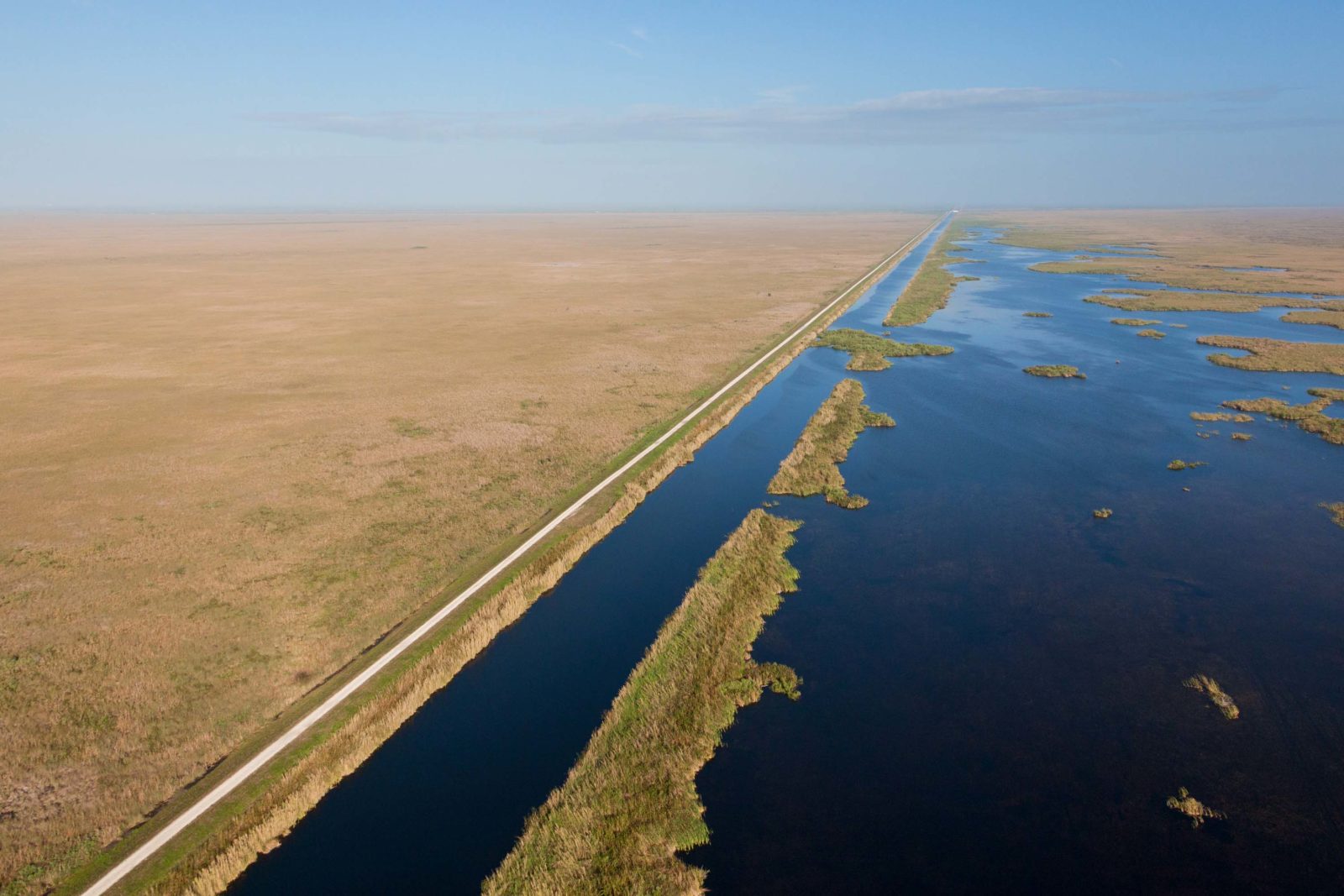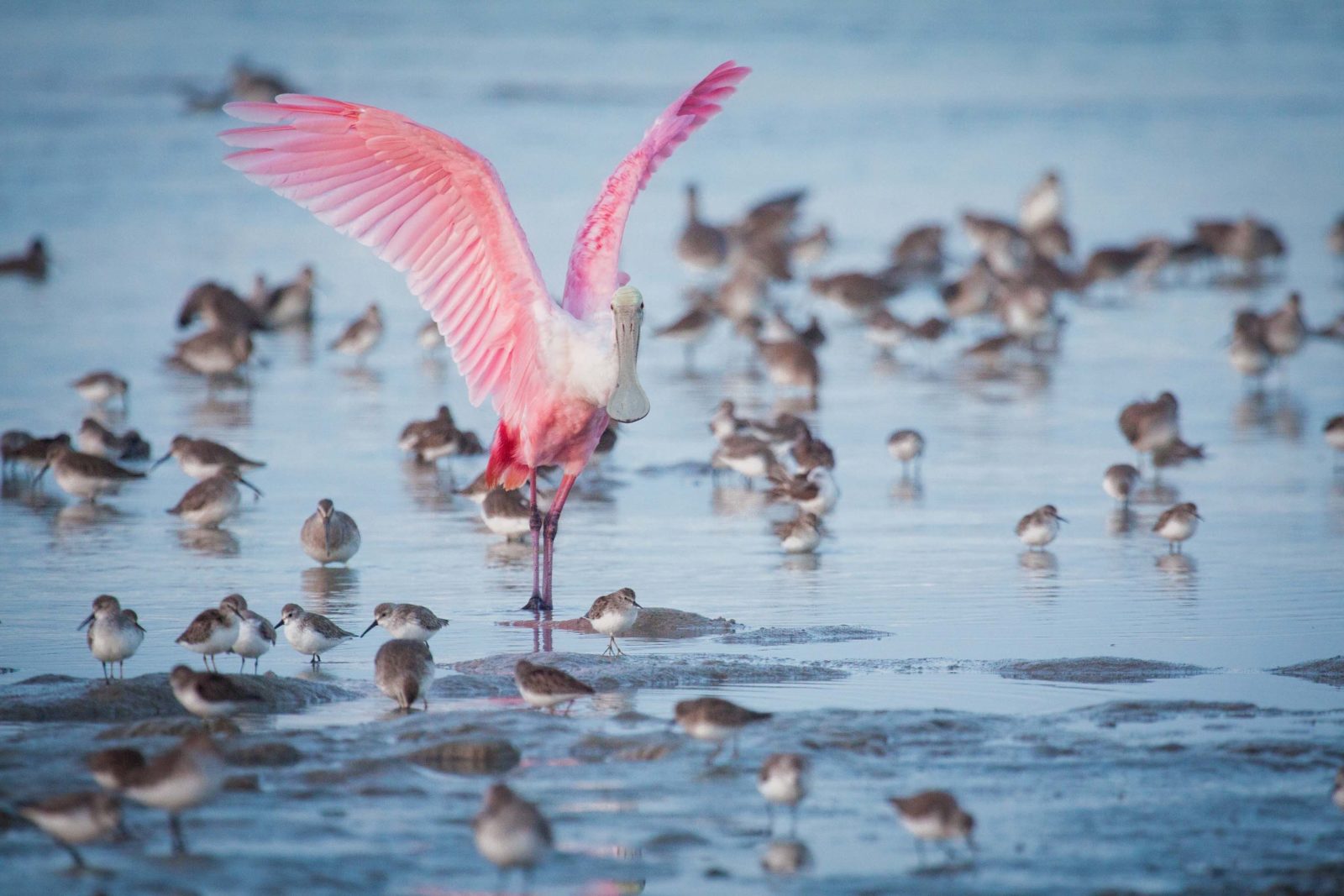Land & Conservation
The Everglades’ Wild Hope
The fate of the South’s last frontier teeters on the brink—after decades of losing ground to environmental devastation, the endangered Florida habitat and its legions of supporters may finally be turning the tide

Photo: Mac Stone
A boater scans the mangrove flats of Florida Bay within Everglades National Park.
We leave Flamingo at sunrise. The fishing guide, Jason Sullivan, guns the throttle of his skiff, beelining us through Whitewater Bay.
We come to a stop in a river mouth—engine cut, wash shooshing against the stern—where the mud gives off the deep, musty smell of fecundity. The early morning air is still, but everything else is astir. Insects thrum in our ears. A phalanx of ibis, snowy egrets, and one Technicolor-pink roseate spoonbill cluck and honk on the shoreline. Big pelicans crash clumsily into the water, scooping up baitfish. On a flat near the riverbank, four dolphins are rounding up—and periodically massacring—a school of mullet. And around us, a few tarpon roll on the surface, their backs glinting silver and pink in the gathering sunlight.
The Everglades—the largest subtropical wilderness in the United States—are where Melville’s “great floodgates of the wonder-world” swing wide open.
Dave Perkins, the executive vice chairman of the Orvis Company, steps up on the bow and begins throwing flawless casts at the tarpon. A little while later, I take my turn. We both come up empty—Sullivan thinks the rowdy dolphins put the tarpon on edge—so we move, making our way to a lake deep in the backcountry, squeezing through an opening in the mangroves just wider than the skiff. There we catch baby tarpon and snook, and spot redfish and largemouth bass.
Perkins tells us about his long history with the Everglades. For him, as for many of us, fishing was his way in. One spring during his teenage years, his father, Leigh, who purchased Orvis in 1965, rented a houseboat and took the family into the backcountry. “That’s when I first fell in love with the Everglades,” Perkins says. Later in life, when he realized what was at stake, that love would begin to manifest itself beyond fishing, in ways that have pushed his company far out of its comfort zone.
The Everglades are dying. On this matter, there is no debate. A century’s worth of dewatering, as well as pollution, dam and canal building, corporate welfare, and indifferent (at best) or bought-and-paid-for (at worst) politicians, has led to one of the greatest ecological tragedies in the country’s history, a fall from Eden that has serious ramifications for human and economic health. The question now for the Everglades—the matter still up for debate—is whether redemption remains possible.
For the first time in two decades, there is, perhaps, reason for guarded optimism, thanks to a rare alignment of interests and events: the unified effort of moderate and radical advocacy groups, some fed-up fishermen, attention-grabbing (and interrelated) environmental devastation on both coasts of Florida, bold corporate activism, and (surprise!) even a few enlightened politicians.
That hope is the good news.
The bad news: We’ve been here before, only to see hope dashed.

Photo: Mac Stone
An alligator in the Fakahatchee Strand State Preserve.
The historical Everglades watershed starts in a small creek some ten miles east of Disney World. More than a century ago, water flowed freely through the Kissimmee River and its chain of lakes and into Lake Okeechobee about one hundred miles south. The water would spill over the lake’s southern bank and then move, in a shallow sheet, down through what is now Everglades National Park to the salt water at the base of Florida. More than 400 species of fish, 350 species of birds, and myriad mammals and reptiles—the Florida panther and the American crocodile included—once thrived in the Everglades. Among the area’s few human inhabitants were outlaws, including Edgar “Bloody” Watson (the notorious murderer whose story Peter Matthiessen fictionalized in Shadow Country), and a few hundred Seminoles who never formally surrendered to the U.S. government after three wars.
Trouble began with a land grab in the late nineteenth century. In 1881, a Philadelphia industrialist named Hamilton Disston purchased four million acres (at a mere twenty-five cents an acre) from the state and began to drain it to reach the rich soil, in which vegetables and fruit could be grown year-round. In 1904, Napoleon Bonaparte Broward ran for governor of Florida—and won—on the issue of further draining for farmers what he called “the fabulous muck.” Melaleuca trees were brought in from Australia to help with the drainage, and they gradually began to displace the native cypresses and saw grass. After major flooding in the 1920s, at the behest of the state and federal governments, the U.S. Army Corps of Engineers built a dike on Lake Okeechobee and started to construct what would become more than four thousand miles of canals, levees, and berms, as well as countless culverts and pumping stations.
It didn’t take long for the draining to impact the ecosystem. Skies once darkened by migrating birds remained open. Some 90 percent of the Everglades’ population of wading birds disappeared. Panther and crocodile numbers plummeted. Several naturalists began to express concern, among them a Connecticut landscape architect named Ernest Coe who had relocated to Miami. Coe became obsessed with establishing a national park to save what was left of the Everglades, becoming a “nuisance,” as he described himself, to those in power. He succeeded. In 1934, Franklin Delano Roosevelt signed a bill that created Everglades National Park, which was officially dedicated in 1947. That same year, a Miami Herald writer named Marjory Stoneman Douglas published The Everglades: River of Grass, a book that celebrated the area and highlighted the conservation steps needed to preserve it. Foremost among them: allowing that shallow sheet of fresh water to flow south, unimpeded, all the way down to Florida Bay.
The 1.5 million–acre park, though just 20 percent of the original size of the historical Everglades, gave reason to celebrate. Its saw grass, pines and cypress, marsh and mangrove forests (which absorb carbon dioxide created by combusted fossil fuels more effectively than any tropical forest), and freshwater and coastal prairies stretched from the outpost town of Chokoloskee in the west (built on an old Calusa shell dumping ground, or “midden”), to the outskirts of Miami in the east, to the southernmost point in the mainland United States in Cape Sable. Everglades National Park remains the last true frontier in the American South, and one of the few left in the country. In its own way, it has become a microcosm of so many fundamental American virtues and vices, of beauty and wildness, of defilement and corruption.
And of sugar.

Photo: Mac Stone
Subdivisions line a canal on the fringe of the eastern Everglades in Parkland.
The victory of establishing the park proved short-lived—a bigger defeat soon overshadowed it, an unfortunate pattern that has persisted to this day in the Everglades. One year after the park opened, Congress passed a law known as the Central and Southern Florida Project, intended to address the impacts of droughts and floods, in order to promote the economic development of the region. The law effectively stanched the free flow of water south to the Everglades from Lake Okeechobee (the Department of the Interior estimates that the historical flow volume has shrunk by two-thirds due to this and other water-control projects) and accelerated the use of the Caloosahatchee River (flowing west from the lake) and the St. Lucie River (flowing east from the lake) as dumping grounds during major water events such as heavy rainfalls. The law also formally established a designated agricultural area south of the lake that would eventually encompass seven hundred thousand acres.
In some ways, the law was merely a myopic product of its time: In 1948, Florida had 2.6 million residents, very few of whom lived in muggy, swampy South Florida (Miami had a population of only 250,000 in 1950). Today more than 21 million people live in the state, including nearly 6 million from West Palm Beach to Miami. That population explosion has taxed Florida’s environment in many ways. But a lack of foresight would not end up being the biggest problem with the law, which remains the operating manifesto today. The way it was written, however, would—giving private companies in the agricultural zone a de facto advantage when it comes to water usage, by establishing and protecting their drain-age and irrigation infrastructure, and by locating them in a plum spot just below the lake.
In 1931, Charles Mott, a Michigander whose wire wheel company had been bought out by General Motors, purchased a bankrupt sugar concern in Florida and renamed it U.S. Sugar. Three decades later, after the revolution forced Alfonso Fanjul Sr. out of his native Cuba, he started a sugar company in the state called Florida Crystals, which is now overseen by his sons Alfonso “Alfy” Fanjul Jr. and Jose “Pepe” Fanjul. The two companies, along with the forty-four-member Sugar Cane Growers Cooperative of Florida, would become the most influential members of what’s informally known as Big Sugar.
U.S. Sugar, Florida Crystals, and other sugar farmers collectively own or manage a majority of the seven hundred thousand acres of agricultural land below Lake Okeechobee (where other crops including oranges and winter vegetables also grow), according to the Treasure Coast Regional Planning Council. Importantly, whenever major rainfall and flooding occur, the Corps of Engineers sends excess water east and west to the coasts instead of down to the agricultural area, while those companies get to drain their lands south to stormwater treatment facilities. For decades, the companies also sent some of it back north, into Lake Okeechobee, where water laden with phosphorus from such sources as fertilizer contributed to the devastating pollution of the lake (today runoff from farms above the lake is the main source of such pollution). Because of both the letter and the interpretation of the 1948 water management law, in times of drought, the sugar companies use the lake’s water to irrigate their lands, ahead of water needs in the Everglades.
The end result of this water management plan: a polluted Lake Okeechobee, a severely dehydrated Everglades, and two polluted estuaries at the mouths of the St. Lucie and Caloosahatchee Rivers. The net winners are the sugar companies.
That’s not the only benefit Big Sugar receives. The United States has a long history of directly and indirectly subsidizing sugar—the first tariffs on imported sugar took effect in 1789. Now the sugar industry receives indirect subsidies such as price supports and limited imports, at a cost to U.S. consumers and food processors of $2.4 billion to $4 billion per year, the American Enterprise Institute’s public policy researchers estimate. The price of raw sugar in the United States is almost twice as high as in the rest of the world.

Photo: Mac Stone
Summer rains rehydrate saw-grass prairies in the central Everglades.
In a 2018 report about the indirect subsidies, the Cato Institute, a libertarian think tank, called the U.S. government “the leader of a nationwide sugar cartel” that benefits the few to the detriment of the many. The report describes the sugar program as “absurd” and “an involuntary wealth transfer from consumer to producers.” Grover Norquist, the president of Americans for Tax Reform, has called the sugar lobby that works to keep these measures in place “cronyism in its undiluted, inexcusable majesty.”
U.S. Sugar and Florida Crystals directed interview requests to Ryan Weston, who is the chief executive officer of the Florida Sugar Cane League, a lobbying firm. Weston refutes the American Enterprise Institute study on indirect subsidies and says that “there has been no cost to the taxpayer for sixteen of the last seventeen years.” He claims that the lower prices of raw sugar outside the United States result from subsidies in other countries. Weston also dismisses the Cato Institute’s assertions, calling the group “a libertarian organization that hates farmers.”
Not that the indirect subsidies are going anywhere—as recently as 2018, the House of Representatives voted down an amendment to the farm bill, 278 to 137, that would have reduced them. One big reason: Big Sugar has its hooks deep into both major political parties. In the 2016 and 2018 election cycles, sugar interests spent $24 million on lobbying and $15.6 million on contributions to federal congressional candidates, parties, and outside groups, spread nearly evenly between Democrats and Republicans (the Fanjuls’ organizations and U.S. Sugar alone accounted for around a third of that contribution total—$5 million).
Marco Rubio, a Republican senator from Florida, received $137,000 in donations from sugar companies across the country in 2016 and 2018 combined, and another reported $486,000 from them for his failed presidential bid in 2016. (When Rubio walked offstage after announcing his candidacy for president, he immediately hugged Pepe Fanjul.) Rick Scott, the state’s former Republican governor who became Florida’s junior U.S. senator in 2019, has taken in more than a million dollars from sugar interests during his time in public office, according to the Tampa Bay Times.
Big Sugar also takes care to spread the wealth across the country, helping to secure its hold on the political system. Debbie Stabenow, a Democratic senator from Michigan, and Mike Conaway, a Republican congressman from Texas, were the two biggest recipients of direct sugar money during the 2018 campaign, receiving $66,200 and $60,300, respectively, as stated by the Center for Responsive Politics, a nonpartisan group that tracks lobbying.

Photo: Mac Stone
A canal along the Tamiami Trail highway exemplifies the drastic stoppage of water that once flowed freely to Florida Bay.
At the state level in Florida, Big Sugar is even more entrenched. The Everglades Trust asserts that sugar interests employed more than a hundred lobbyists in 2017 (Florida has 160 state legislators). The Tampa Bay Times reported that the sugar industry spent $57.8 million on state and local politicians from 1994 to 2016, led by U.S. Sugar’s $33.3 million and the Fanjuls’ $12.4 million.
And yet, for all that, there have been moments when the restoration of the Everglades has appeared to overcome Big Sugar’s political might. One of them, almost twenty years ago, nearly turned the tide.
By the 1970s and ’80s, decades of curtailed water supply began to take its toll on the Everglades, and several conservation groups ramped up their advocacy. The National Audubon Society expressed alarm at the reduced bird populations. The Sierra Club commenced advocating on behalf of the entire ecosystem. But it was two fishermen who pushed the conservation efforts into the national spotlight.
From 1987 through 1989, a severe drought gripped Florida. In large part because of the sugar concerns’ established infrastructure, very little fresh water entered the Everglades. Without the needed influx, the seagrass of Florida Bay—the terminus of that freshwater flow at the base of the park—started to die off, and the redfish and snook disappeared. Shocked and dismayed by this development, two men who frequently fished the bay together—Paul Tudor Jones, a hedge-fund billionaire, and George Barley—decided to do something about it.
In 1993, the two men formed the Everglades Foundation. (Barley would die two years later when his plane crashed on the way to meet with the Corps of Engineers to talk about Everglades water.) The scientific work the group produced proved invaluable. They demonstrated that water flowing south was essential to the drinking water supply from Palm Beach to the Keys, and that it mitigated the growing problem of sea level rise. They pointed out that the Everglades provide a natural buffer for hurricanes. These findings eventually received national attention and forced the hand of some important politicians who were friendly with Big Sugar.
On December 11, 2000, Jeb Bush, then the governor of Florida, stood in the Oval Office as President Bill Clinton signed into law the Comprehensive Everglades Restoration Plan (CERP)—an $8 billion, thirty-year agenda. That the law had been championed by a governor who had often sided with the sugar industry, and signed by a president who had taken money from Big Sugar (according to The Starr Report, Clinton once interrupted a chat with Monica Lewinsky to take a call from Alfonso Fanjul), felt like a consequential moment in the fight for the fragile ecosystem. CERP featured sixty-eight components designed to get the necessary water to the Everglades, and ensuing laws ensured that sugar producers upheld stricter pollution standards.

Photo: Mac Stone
A sugarcane plant in Belle Glade.
But it all fell apart rather swiftly. The federal government rarely provided the pledged money in its annual budgets. Then, just three years after that day in the Oval Office, Jeb Bush signed a state law that weakened water pollution standards for the sugar companies. According to the National Academies of Sciences, Engineering, and Medicine’s most recent biennial, congressionally mandated study, though some progress has taken place in recent years, the health of the Everglades stands today pretty much where it did two decades ago. A few related projects have been completed, including two new bridges on the Tamiami Trail (the highway that runs east to west across the Everglades). Along with a raised roadbed, they will, in theory, allow more water into the Everglades and Florida Bay. The only thing missing? Additional water. So far, anyway.
But, just maybe, a chance now exists that there someday will be more. That sliver of hope comes from an unlikely source: the recent, well-publicized ecological disasters in two Florida estuaries that happened to be directly related to the plight of the Everglades.
In the early 2000s, an Internet entrepreneur named Chris Maroney sold a domain auction company, retired, and decided to spend much of his new free time fishing. He bought a house in Stuart, Florida, and haunted the grass flats at the mouth of the St. Lucie River. “I had seven years of truly great fishing,” Maroney says. Then came 2013.
Heavy rains that spring filled Lake Okeechobee and strained its barriers. In order to ease the mounting pressure on the lake without dispatching water south over the agricultural area, the Corps of Engineers started releasing hundreds of billions of gallons west through the Caloosahatchee River and east through the St. Lucie. The sheer volume posed a significant problem for the estuaries at the rivers’ mouths. That the water was polluted with cyanobacteria, also known as blue-green algae, compounded the problem. In the St. Lucie estuary, oysters and seagrass died. “And the fishing was done,” Maroney says.
It wasn’t the first time this had happened in the St. Lucie estuary, and residents knew it wouldn’t be the last. “Everyone was angry and frustrated,” Maroney says. “But we weren’t getting at the real problem, which was the preference the sugar companies got with the water.” The next year, Maroney cofounded a group named Bullsugar.org, which adopted a tone radically different from that of its fellow advocacy groups, using social media to go after politicians who accepted money from Big Sugar. “We think radical is appropriate now,” Maroney says.
In 2016, heavy rains once more caused water from Okeechobee—again, polluted with cyanobacteria—to be forced into the rivers and estuaries on the east and west coasts. Dead fish lined the shores. Dogs died after eating the fish. Pediatricians began to ask parents if their kids had swum in the water. Bullsugar shared images of the algae and the dead fish all over the Internet. Real estate prices near the estuaries fell, and tourism rates dropped. The ensuing outrage catalyzed the movement. The public started to realize that the polluted estuaries and the suffering Everglades were all part of the same problem. New groups, including Florida Bay Forever and Captains for Clean Water, joined the fray.
Like all movements, this one had its share of internal disagreements. All of the groups wanted to save the Everglades and the estuaries, but their tactics for getting there differed. The lack of accord threatened to squander the moment, perhaps one of the last the Everglades would ever have. The groups needed a convener, and one emerged: a grizzled veteran of the fly-fishing industry.

Photo: Mac Stone
Toxic, alga-laden water reaches the town of Stuart in 2018. Health advisories warned people to avoid the water.
Sandy Moret is a calm straight shooter, a fly-fishing luminary who runs Florida Keys Outfitters in Islamorada and knows pretty much everyone in the business and beyond. Moret became heavily involved in Everglades conservation in the 1970s, and took part in the movement that had helped lead to CERP. He had lost track of some of the burning issues over the years, but after a severe grass die-off in Florida Bay in 2016, Moret decided it was time to get involved again. That year, he attended an Everglades water management meeting. “I walked out shaking my head,” he says. “It was pretty clear that nothing had really been done in twenty-five years, and that restoration was dead.”
So Moret, with input from Bullsugar’s Maroney, decided to create a document, eventually named the Now or Neverglades declaration, that simply and clearly laid out the problem (the collapse of three estuaries) and the solution (to store and treat more water, and convey more of it south). Moret’s task was to get all of the advocacy groups involved under one umbrella, which he did with aplomb—783 of them have signed the declaration, including entities as disparate as the Everglades Foundation, the League of Women Voters of Florida, the Sanibel Captiva Chamber of Commerce, and companies such as Orvis and Patagonia. “Sandy was the center of gravity on this,” says Stephen Davis, the senior ecologist at the Everglades Foundation.
The declaration gave Everglades advocates something new: a political wedge. Hundreds of politicians received it. Some signed it. Some ignored it. “Now someone like Rubio, who says he’s for restoration but does nothing about it, could be called out,” Maroney says. (Rubio, in fact, ignored the declaration.)
The Now or Neverglades coalition first flexed its muscles in 2017, helping to pass Florida Senate Bill 10 (SB 10), which provided for a reservoir and treatment plant below Okeechobee that would get clean water south. Orvis’s involvement helped push the bill over the edge—the company took out a full-page ad in the Miami Herald advocating for the bill, and launched a social media and email push that reached millions of people. “I give Orvis credit for sticking its neck out,” says the Everglades Foundation’s Davis. “They drew a lot of attention to the issue and legitimized what we were doing.” Orvis’s Dave Perkins says that sticking up for natural resources “is always good business for us.” But with its ads—the company ran two follow-ups in the Herald—and Internet blasts, Orvis took its corporate advocacy much further than it ever had. “We didn’t care if we pissed some people off,” Perkins says. “This is too important.”
Among those perturbed by the calls for more water for the Everglades, of course, were the sugar companies. Weston, of the Florida Sugar Cane League, asserts that there was already enough water flowing south for the Everglades, and says sugar farmers “support the restoration of the Everglades to the fullest extent possible,” citing tax and other contributions of $450 million toward that goal, and a 57 percent average reduction in phosphorus leaving the farms since 1994. Weston contends that all groups—even the sugar companies—are in this fight together. “We don’t get anywhere by throwing bombs,” he says. He adds that he doesn’t consider Bullsugar to be “a real organization” and believes that the Everglades Foundation still fights for its cause “because it’s a fund-raising group.”

Photo: Mac Stone
Wild sunflowers bloom en masse in Audubon’s Corkscrew Swamp Sanctuary.
Big Sugar continues to wield its political influence. In 2008, the state began a deal to buy land below Lake Okeechobee from U.S. Sugar to help restore water flow to the Everglades. After years of scaling back the amount it would purchase, Florida acquired 27,000 acres, only about one-seventh of the original proposal, according to the Tampa Bay Times. In 2015, then governor Rick Scott and the South Florida Water Management District declined the option to buy more. (Scott’s political action committee already had $1 million in contributions from sugar interests when he made the decision, according to the newspaper.) Just before Scott left office in late 2018, the SFWMD board, all of whose members he had appointed, voted unanimously—and, environmental groups claim, without giving the public proper notification—to extend a Florida Crystals subsidiary’s lease on the land where the new SB 10 reservoir was to be built, potentially delaying the project for many years. (The board said stipulations in SB 10 gave it no choice but to approve the lease.) Even the win of passing SB 10 has been muted: The original plan for a 60,000-acre reservoir to hold—and eventually clean—Everglades-bound water has been reduced to a mere 10,100 acres, which some consider woefully inadequate. (On the bright side: Reports in June said construction would start in October.)
By the 2018 election, however, there was a slight but significant shift in the political winds. The images of the tainted floodwater in the estuaries to the east and west, along with the awareness raised by the Now or Neverglades coalition, had spurred the electorate—plus, economic interests in Florida were now at stake. The nasty discharges badly impacted Florida’s $9.6 billion fishing industry, its $23.3 billion boating industry, and its $88 billion tourism industry as a whole. Real estate suffered, too. The Florida Realtors association estimated that the 2013 discharges—which caused less damage than the 2016 ones—accounted for nearly a half billion dollars in reduced property values in one of the counties containing the St. Lucie River.
Ron DeSantis, the Republican candidate for Florida governor in 2018, publicly declared that he would not take any money from Big Sugar, and ran on a platform of restoring the Everglades and the estuaries. He won, by just 34,000 votes. “I think we [water activists] definitely helped put him over the top,” says Moret, of Now or Neverglades. Some believe tourism and real estate reasons motivated DeSantis. But with politicians, says the Everglades Foundation’s Davis, “who cares how the light bulb goes on, just as long as it does.” DeSantis has followed through on his campaign pledges, pushing for restoration and asking for—and getting—the resignations of the Scott-appointed board members who extended the Florida Crystals subsidiary’s land lease.
Another leading political light in the fight for the Everglades is Brian Mast, a Republican congressman who serves the eighteenth district, which stretches from Fort Pierce down to Palm Beach on the state’s east coast. When Mast first ran for Congress in 2016, he received a donation from Florida Crystals and the Fanjuls. He gave it all back shortly thereafter. “It wasn’t an easy decision to make,” Mast says. “It’s a lobby that will give you money for as long as you’re in office. But I couldn’t do it. I wanted to be able to be fair and honest.”

Photo: Mac Stone
A roseate spoonbill forages at Lake Ingraham, in Everglades National Park. Scientists monitor the birds’ numbers as an indicator of the overall health of the watershed.
Mast has seen the destruction wrought by the current arrangement up close; he lives across the street from the St. Lucie River. “I live, eat, and breathe this issue,” he says. “Man messed up something beautiful, and we need to fix it.” He is careful to note that he wants the farmers to get water. “I just don’t want that to be at the expense of the Everglades and the estuaries,” he says. He voted to reduce the indirect sugar subsidies in the House in 2018 but doesn’t think that’s the way forward on the issue.
“Unfortunately, I don’t think the sugar subsidies will ever go away,” he says. “They have too much support in the state and the rest of the country.” Instead, he has concentrated on introducing bills in Congress. His most recent one would amend the 1948 law, to prioritize the health of humans and the ecosystem. And, in an important moment this summer, he got the Army Corps of Engineers to admit that the water being dumped from Lake Okeechobee into the estuaries on the east and west coasts during floods is, in fact, toxic. The admission, ideally, will decrease the amount of water sent to the coasts and put pressure on the government to hasten the building of the new Everglades reservoir and water treatment project.
Hope has always been a tricky thing when it comes to the Everglades. Political winds are fickle, of course, and DeSantis and Mast, for the good they’ve done and may do in the future, won’t stay in office forever. We’re close to the point of no return. “I think we have twenty years to fix this problem,” says Chris Maroney. “We’ll know by then what the future holds.”
I think about Maroney’s words as Sullivan, Perkins, and I make our way back to the launch at Flamingo after our day spent deep in the Everglades. The arguments for restoration that involve money, health, and tourism are obviously very important. All of them can and should be used as political cudgels. In the end, it’s up to us—citizens and voters—to make sure that happens. But as I watch the late afternoon sun begin its gradual fade over the inscrutable labyrinth of mangroves in this wonder-world, I think: If this alone—the very existence of a place like this—doesn’t matter enough to do what’s right, what does?







